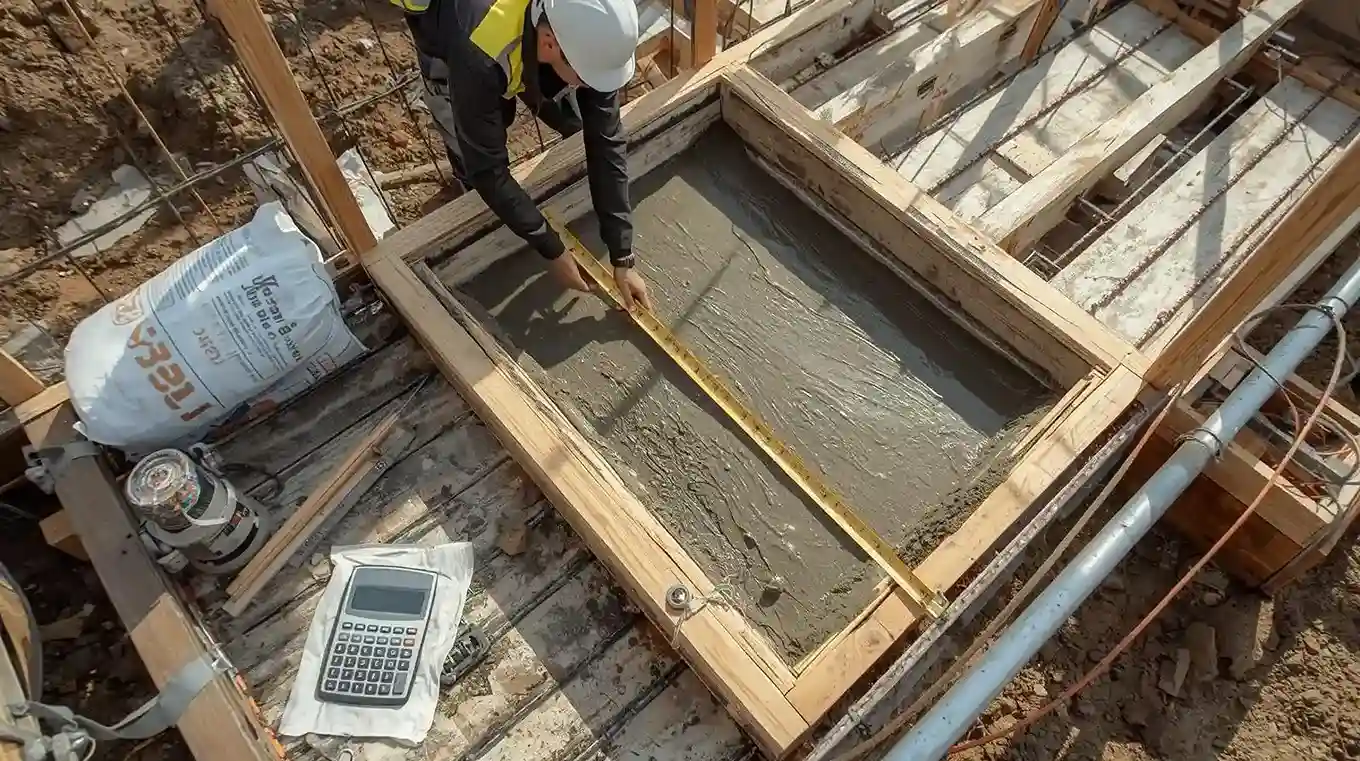How to Calculate a Yard of Cement for Concrete
Understanding how to calculate a yard of cement is essential for builders, contractors, and DIY homeowners who want to ensure they mix the right amount of materials for a concrete project. Whether you’re pouring a driveway, a slab, or a foundation, knowing how to measure and calculate cement yardage ensures cost efficiency, material accuracy, and structural strength.
This guide explains the formula, steps, examples, and professional tips to accurately calculate a yard of cement for concrete. You’ll also find internal resources from AsphaltCalcApp and references to official construction authorities to ensure reliability and compliance with construction standards.
🧱 What Does “A Yard of Cement” Mean?
A yard of cement refers to the volume of material required to produce one cubic yard (27 cubic feet) of concrete mix. However, pure “cement” is rarely used alone — it’s mixed with sand, aggregate, and water to create concrete.
When professionals say “a yard of cement,” they typically mean a yard of concrete mix that includes cement as one of the components.
According to the Portland Cement Association (PCA), one cubic yard of concrete contains about 517 pounds of cement on average, depending on strength and application.
🧮 Formula to Calculate a Yard of Cement
To determine how much cement you need for one cubic yard of concrete, use this base formula:
Volume (cubic yards) = Length (ft) × Width (ft) × Thickness (in) ÷ 324Then, multiply the total cubic yards by the standard cement requirement for the desired concrete mix.
Example:
- Length = 10 ft
- Width = 10 ft
- Thickness = 4 in
Volume = (10 × 10 × 4) ÷ 324 = 1.23 cubic yards
If each cubic yard requires approximately 517 lbs of cement, then:
1.23 × 517 = 635.9 lbs of cementThat means you need roughly 636 pounds (about 6.4 bags) of cement for this slab.
⚙️ Conversion Factors You Should Know
- 1 cubic yard = 27 cubic feet
- 1 bag of cement (94 lbs) = 1 cubic foot of cement
- 1 cubic yard of concrete = approx. 517 lbs of cement, 1,560 lbs of sand, and 1,600 lbs of gravel
For easy and instant calculations, use the free Cement Block Calculator on AsphaltCalcApp — a tool designed for accurate material estimation in construction projects.
🧰 Step-by-Step Process to Calculate Cement Yardage
- Step 1: Measure your project’s dimensions (length, width, and depth).
- Step 2: Convert the thickness into feet or inches as needed.
- Step 3: Use the formula to find cubic yards.
- Step 4: Multiply the result by the cement requirement per cubic yard.
- Step 5: Round up your result — always order 5–10% extra to account for wastage.
Professional engineers often rely on the Concrete Network yardage chart to cross-check their calculations.
📏 Common Project Examples
| Project Type | Thickness | Approx. Cement (per sq. ft.) | Notes |
|---|---|---|---|
| Driveway | 4 inches | 0.011 cubic yards | Medium-strength mix |
| Patio or Walkway | 3 inches | 0.009 cubic yards | Light to medium load |
| Foundation Slab | 6 inches | 0.018 cubic yards | Heavy load or structural mix |
🌎 Global Relevance
This method applies worldwide — whether you’re in the U.S., UK, Pakistan, India, or the Middle East — the yardage formula remains consistent. However, local cement brands and standards (such as ASTM C150 in the U.S. or BS EN 197 in Europe) may differ slightly in weight and mix ratio.
For regional professionals, Asphalt Tonnage Calculator and Sand Calculator can help plan full construction material quantities across projects.
🧩 Advanced Tips for Accurate Cement Yardage
- Always calculate volume in **cubic feet first** before converting to cubic yards.
- Use a **moisture correction factor** if your sand or aggregate is wet.
- Include a **wastage margin** (typically 5–10%).
- Double-check unit conversions — inches vs. feet errors are the most common mistake.
- For large projects, use a DOT-approved mix design for strength and safety compliance.
📘References
- Federal Highway Administration – Concrete Mix Design
- Portland Cement Association – Learning Center
- Concrete Network – Concrete Yardage Guide
- The Constructor – Civil Engineering Portal
- Wikipedia – Cubic Yard Unit Reference
❓ Frequently Asked Questions (FAQs)
1. How many bags of cement make one yard of concrete?
Typically, you’ll need about 5.5 to 6 bags of cement (94 lbs each) for one cubic yard of concrete, depending on the desired strength and mix ratio.
2. What is the difference between cement and concrete yardage?
Cement is just one ingredient in concrete. Cement yardage refers to the volume of cement, while concrete yardage measures the total mix (cement, sand, gravel, water).
3. How can I calculate cement yardage without formulas?
Use a reliable online tool such as the Cement Block Calculator or Concrete Calculator on AsphaltCalcApp for instant and accurate results.
4. Can I use this method for mortar or plaster?
Yes, but you’ll need to adjust ratios — mortar and plaster mixes typically require more cement and less aggregate.
5. What’s the best cement mix for durability?
For most residential slabs, a 1:2:3 mix (cement:sand: aggregate) is standard. For heavy-duty structures, opt for a 1:1.5:2 mix.
🏁 Final Thoughts
Knowing how to calculate a yard of cement for concrete helps you plan projects efficiently, minimize costs, and ensure strength and durability. Whether you’re working on small DIY slabs or professional construction, accurate cement yardage calculation saves time and prevents overmixing or shortages.
For precision and speed, try the free Cement Block Calculator and Concrete Calculator on AsphaltCalcApp — your trusted digital assistant for accurate material estimation.
Written and reviewed by construction experts, verified through official resources.

